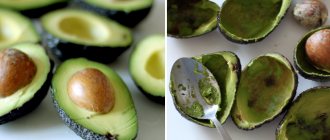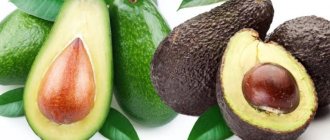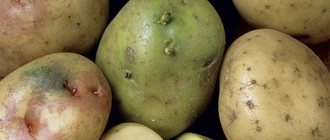Once ripened, you have a narrow window of time—usually a few days—before the fruit begins to spoil ().
You may be wondering how to tell when an avocado has gone bad and is no longer ready to eat.
Here are 5 signs that your avocado has gone bad.
How do you know if an avocado has gone bad?
Overly soft with bruised skin
When checking for ripeness, use the palm of your hand to gently squeeze the avocado. Do not press the fruit with your fingers as this may damage the flesh.
If the avocado is very hard and cannot be pressed at all, it means it is unripe. If it gives a little, it's probably ripe and ready to eat.
However, if squeezing leaves small indentations, the fruit may be too ripe to cut and would benefit from being pureed.
The fruit is overripe and probably spoiled, perhaps if pressure leaves large dents and the fruit becomes soft.
Also, if the avocado already has dents in it before you squeeze it, it has probably already started to go bad ().
Summary:
If you gently squeeze an avocado in the palm of your hand and it forms large indentations where you pressed, the fruit is overripe and likely spoiled.
Conclusion
Avocado is an exotic fruit that contains the entire set of B vitamins, nutrients A, D, E, C, PP, minerals: phosphorus, sodium, magnesium, potassium, manganese, calcium, iron. Despite its high energy value (167 calories per 100 grams of pulp), the fruit is considered a dietary product and is recommended for daily consumption by all healthy people.
The beneficial properties of avocado are due to the high content of the following nutrients:
- antioxidant glutathione, prolongs the youth of the body;
- lutein, protects the organs of vision from cataracts, macular degeneration of the retina;
- beta-syntosterol, lowers cholesterol levels;
- folic acid, strengthens the heart.
How to choose a ripe avocado?
- The skin of the fruit must be clean, without stains, cracks, dents, or damage.
- The color of ripe fruit is uniform, close to black.
- When pressed, the fruit should squash slightly.
Green avocado tastes like an unripe pear or pumpkin, has a hard peel and dense flesh. The ripe fruit has a subtle nutty aftertaste, reminiscent of a puree of butter and herbs.
How to ripen green avocado at home?
To improve the taste and soften the texture, do not put the fruit in a cold place, store it at room temperature. It will ripen in 2 – 3 days.
Blackened peel
Some avocados undergo distinct changes in skin color as they ripen, especially the Hass variety, which accounts for about 80% of avocados eaten worldwide ().
When Hass avocados are not fully ripe, they have a bumpy, bright green skin. When ripe, it turns dark green or brown. If the skin looks almost black and the fruit feels soft when touched, it is overripe and probably spoiled.
Other varieties, including Zutano and Fuerte, retain their green skin color no matter how ripe they are. Use other methods, such as feeling for firmness, to determine whether they are ripe or spoiled.
Summary:
Hass, the most common variety of avocado, has blackened skin when overripe or spoiled. However, other varieties retain their green color when overripe.
Historical information
The history of the appearance of the fetus began 10 thousand years ago. It is assumed that the origin of the culture is connected with the agricultural tribe of Central America, which crossed several species of plants. The modern name "avocado" comes from the name of the ancient Aztec plant - "ahuacatl". Interestingly, the tender fruits are the favorite food of many land animals living in the tropics. They spend a long time looking for fallen, juicy avocados on the ground. This is where the next name of the culture came from - “crocodile pear”.
The first acquaintance of Europeans with the exotic fruit occurred in the 15th century. And in the 17th century, avocados were brought to Southeast Asia and the west coast of Africa by Spanish and Portuguese sailors. Until the beginning of the 20th century, the fruits of the evergreen tree were considered typical crops of local importance. Only at the end of the 20th and beginning of the 21st centuries did they acquire a commercial character.
Where does alligator pear grow?
Today, there are 600 varieties of avocados that grow in different parts of the world with tropical, subtropical climates (East Asia, America, Africa, Oceania). The most common types: Fuerte and Hass. They have a rich, deep buttery aroma and excellent taste. In new varieties, the weight of the fruit is 200 - 400 grams, and the pulp accounts for up to 93% of the total weight of the fruit.
Dark, striped flesh
Once you cut an avocado, it's much easier to tell if it's gone bad. Of course, this option is only suitable if you have already bought the fruit.
Avocados that are ready to eat have light green flesh. Rotten pulp has brown or black spots ().
However, an isolated brown spot may be due to dents rather than widespread deterioration and can be cut off.
Another possible sign of rotting is dark streaks in the flesh.
However, some avocados, especially those picked from young trees, may have dark streaks even if they are not rotten. If the fruit looks good and does not taste bad, it is safe to eat.
Likewise, the texture of an avocado can be uneven when it's spoiled. However, if there are no other signs of rot, this is not necessarily a bad thing. The fibrous texture can also be attributed to growing conditions ().
Summary:
Spoiled avocado flesh has dark spots and a streaky texture that tastes bad. However, isolated areas of discoloration may be associated with dents.
Is it possible to eat an avocado that is black inside, bitter, darkened, with brown streaks?
Is it possible to have an avocado that is brown in the middle and what to do if it tastes bitter?
Avocados are grown in areas with tropical and warm climates. After harvesting, the fruits do not immediately reach store shelves. During transportation, part of the harvest becomes unusable, so owners very often collect unripe fruits. Impaired storage or transportation options can result in loss of flavor quality and changes in texture. Whether avocados are black in the middle or not is a question that worries consumers who select vegetables and fruits in stores and points of sale.
What are black dots in the middle of an avocado?
The appearance of black dots in the middle is associated with technical ripeness. Ripeness is formed according to a number of characteristics:
- the imprint quickly disappears when pressed lightly, the shell takes its former shape;
- the area where the cutting was placed becomes green, with brown accents;
- when you press on the handle, the oil accumulated in the middle can penetrate out;
- when shaking in the middle, you can hear the tapping of the bone;
- The bone is easily detached from the pulp: it can be removed with a spoon.
The appearance of the peel will not say anything about the ripeness or preservation of the pulp in the middle. Depending on the variety, the peel has green, brown and transitional colors.
You can determine whether an avocado can be eaten by the color and structure of the pulp. If the pulp is covered with black dots in the middle, this may indicate a violation of storage rules. The appearance of black spots occurs due to the fact that the fruit was stored primarily in an unheated room, and then it gets into the heat.
The answer to the question whether there is pulp with black dots in the middle also depends on how much blackness is present on the surface. If the black spot is located far from the seed and the area covered by it is approximately 10% of the entire fruit, in other words, such a fruit can be removed by removing the black spots with a spoon in advance. Very small black dots are picked out with the sharp end of a knife, and then the pieces of pulp are used for their intended purpose. Such pieces will not become bitter or have any other unpleasant taste.
If a black spot completely surrounds the pit on two halves, and when removed it turns out to be present at all levels in the middle of the pulp, then such a fruit should not be eaten. In this case, there are several reasons for the appearance of black spots:
- sudden change in climate conditions during storage;
- long stay at low temperature;
- disruption of transportation options;
- possible stay in the water mass and further drying.
A black spot is considered evidence of overripeness. With a high prevalence, it threatens the fruit with loss of quality taste and good properties. It is better not to have such a fruit, because it will probably taste bitter and, moreover, lose its good properties.
Is it possible to eat darkened avocados?
Avocado has long been considered an exotic fruit, but recently its presence on store shelves has become commonplace. Despite this, consumers are not fully familiar with the specifics of this culture. Many people are frightened by the ability of the fruit to darken after cutting. There's really nothing scary about it. The thing is that the pulp has a very high amount of iron in the middle. Upon contact with air, an oxidation reaction begins. This causes the separated halves to darken.
What is necessary to prevent avocados from turning dark?
To protect the pulp from darkening for some time, it is sprinkled with lemon juice. This will delay the oxidation process.
Another method that helps prevent darkening is to generously lubricate the cut halves with olive oil. The unused parts are then stored in an airtight container in the refrigerator.
Why is avocado bitter?
Often, after successfully choosing a fruit, it turns out that it tastes bitter when consumed. If, apart from bitterness, the avocado has brown veins in the middle, this means that the fruit is completely overripe. There will be no benefit from its use, and it cannot be eaten. Moreover, the taste of dishes prepared with it will suffer.
An additional cause of bitterness may be the unripeness of the avocado: in this case, it will be light yellow in the middle, with a bitter taste.
The pulp also begins to taste bitter after thermal treatment. In most cases, it is started raw, so as not to be exposed to high temperatures, which destroy the structure and contribute to the loss of good properties.
Is it possible to eat avocados if they are bitter?
In most cases, unripe or overripe fruit tastes different. Overripe fruit compensates for the bitterness with an oily and soft structure.
An unripe avocado in the middle will be bitter to such an extent that it will be simply impossible to enjoy eating it. Bitterness does not mean that the fruit loses its good properties or becomes harmful: it is only a sign of the level of ripeness and a characteristic of the quality of taste.
What to do if your avocado is bitter
If the fruit is overripe, it will first of all taste bitter. You can veil this taste with additional ingredients. Everything here depends on the skill of the cook or housewife.
If the avocado is bitter due to insufficient ripeness, then you can leave it for a couple of days to lose the bitterness through ripening. For this purpose, use one of several options.
- Place the pieces in a container, sprinkling well with lemon juice. After 3 – 4 days after storage, the fruit will no longer taste bitter and can be eaten.
- Uncut fruit must be left to ripen. To do this, it is wrapped in food paper and removed for a couple of days to where it is dark and dry.
Conclusion
Whether there is an avocado that is black in the middle or not is decided depending on the causes of the black spots. Small black spots on the surface of fresh fruit will not cause damage. A spreading black spot, which is considered a precursor to the decomposition process and evidence of spoilage, is a signal that such a fruit should not be eaten. Moreover, you need to know that unripe avocados can be bitter and hard, so a suitable option would be to leave such fruit for ripening.
By taste or smell
Ripe avocados have a pleasant, slightly sweet aroma and a slightly nutty taste. As the fruit spoils, its taste and smell may deteriorate.
If it tastes or smells sour, it may have bacterial spoilage and should be discarded ().
A chemical smell and taste may mean it is rancid. This can happen when oxygen or microbes damage or break down the fruit's unsaturated fat ().
Rancidity can lead to the formation of potentially toxic compounds. Don't eat an avocado if you think it's rancid ().
The taste of spoiled avocados can vary, but it's usually easy to tell if they've gone bad based on the taste.
You can tell if an avocado has gone bad by smell, taste, touch, and visual inspection.
Summary:
A sour taste or smell, as well as a rancid aroma and chemical taste mean the avocado is spoiled and you should discard it.
Is it possible to eat an avocado that is brown inside and what to do if it’s bitter?
Avocados are grown in areas with tropical and subtropical climates. After harvesting, the fruits do not immediately reach store shelves. During transportation, part of the harvest spoils, so owners often collect unripe fruits. Violation of storage or transportation conditions can lead to loss of taste and change in structure. Whether an avocado is black inside or not is a question that worries consumers who choose vegetables and fruits in supermarkets and retail outlets.
What are black spots inside an avocado?
The appearance of black dots inside is associated with technical ripeness. Ripeness is determined by several criteria:
- the mark from light pressure quickly disappears, the shell takes its previous shape;
- the area where the cutting was located becomes green, with brown spots;
- when pressing on the handle, the oil accumulated inside may seep out;
- when shaking inside, you can hear the tapping of the bone;
- The bone is easily separated from the pulp: it can be removed with a spoon.
The appearance of the peel will not say anything about the ripeness or safety of the pulp inside. Depending on the variety, the peel has green, brown and intermediate colors.
Whether an avocado can be eaten can be determined by the color and structure of the pulp. If the pulp is covered with black dots inside, this may indicate a violation of storage rules. The appearance of black spots occurs due to the fact that the fruit was first stored in a cold room, and then it gets into the heat.
The answer to the question whether it is possible to eat pulp with black dots inside also depends on how much blackness is spread over the surface. If the black spot is located far from the seed and the area covered by it is approximately 10% of the total, then such fruit can be removed by first removing the black spots with a spoon. Small black dots are picked out with the sharp tip of a knife, and then the pieces of pulp are used for their intended purpose. Such pieces will not taste bitter or have any other unpleasant taste.
If the black spot completely surrounds the pit on both halves, and when removed it turns out to be widespread at all levels within the pulp, then the fruit should not be eaten. In this case, there are several reasons for the appearance of black spots:
- sudden change in climatic conditions during storage;
- long stay at low temperatures;
- violation of transportation methods;
- possible stay in water and subsequent drying.
A black spot is evidence of overripeness. With maximum spread, it threatens the fruit with loss of taste and beneficial properties. It is better not to eat such fruit, since, most likely, it will taste bitter and, in addition, will lose its beneficial properties.
Is it possible to eat a darkened avocado?
Avocado has long been considered an exotic fruit, but recently its presence on supermarket shelves has become commonplace. Despite this, consumers are not fully familiar with the characteristics of this culture. Many people are frightened by the ability of the fruit to darken after cutting. In fact, there is nothing wrong with this. The fact is that the pulp contains an increased amount of iron inside. Upon contact with air, an oxidation reaction begins. This causes the cut halves to darken.
What do you need to prevent avocados from turning dark?
To protect the pulp from darkening for a while, sprinkle it with lemon juice. This will delay the oxidation process.
Another method that helps prevent darkening is to generously lubricate the cut halves with olive oil. After this, the unused parts are stored in an airtight container in the refrigerator.
Why is avocado bitter?
Often, after successfully choosing a fruit, it turns out that it tastes bitter when consumed. If, in addition to bitterness, the avocado contains brown streaks inside, this means that the fruit is completely overripe. There will be no benefit from its use, and you should not eat it. In addition, the taste of dishes prepared with it will suffer.
The second reason for the appearance of bitterness may be the unripeness of the avocado: in this case, it will be light yellow inside, with a bitter taste.
The pulp also begins to taste bitter after heat treatment. Usually people start eating it raw, so as not to expose it to high temperatures, which destroy the structure and contribute to the loss of beneficial properties.
Is it possible to eat avocado if it tastes bitter?
Unripe or overripe fruit usually tastes different. Overripe fruit compensates for the bitterness with an oily and soft texture.
An unripe avocado will be bitter inside to such an extent that it will simply be impossible to enjoy eating it. Bitterness does not mean that the fruit loses its beneficial properties or becomes harmful: it is just a sign of the level of ripeness and a characteristic of taste.
What to do if your avocado is bitter
If the fruit is overripe, it will definitely taste bitter. You can mask this taste with additional ingredients. It all depends on the skill of the cook or housewife.
If the avocado is bitter due to insufficient ripeness, then you can leave it for several days to lose bitterness through ripening. For this purpose, you can use one of several methods.
- Place the pieces in a container, sprinkling generously with lemon juice. After 3–4 days after storage, the fruit will no longer taste bitter and can be eaten.
- Uncut fruit should be left to ripen. To do this, it is wrapped in food paper and put away for several days where it is dark and dry.
Conclusion
Whether an avocado is black inside or not is decided depending on the reasons for the appearance of black spots. Small black spots on the surface of a fresh fruit will not cause harm. A spreading black spot, which is a precursor to the rotting process and evidence of spoilage, is a signal that such a fruit should not be eaten. In addition, you should know that unripe avocados can be bitter and hard, so the best option would be to leave such fruit to ripen.
Mold
Mold on avocados is usually white or gray and has a fuzzy appearance. Do not inhale it, as you may inhale mold spores and cause breathing problems if you are allergic to it.
Avoid buying avocados with mold on the outside, as it can penetrate into the flesh and cause the entire fruit to spoil.
If you cut an avocado and see mold, discard the entire fruit. Although you may only see mold in one area, it can easily spread through the pulp. Do not try to save the fetus ().
Summary:
Mold is a clear sign that the avocado has gone bad. You should discard the entire fruit as mold may spread through the flesh but may not be completely visible.
How much can you eat per day?
For many adherents of a healthy diet, avocado is an indispensable product for daily consumption, however, being a high-calorie fruit, you need to know how much of it you can eat per day.
Nutritionists advise eating avocados every day, but only if the quantity does not exceed one. It is worth remembering that excessive consumption of a high-calorie product can affect your figure and well-being: cause heaviness in the stomach, nausea, and a feeling of discomfort.
Safety of overripe avocados
Whether an overripe avocado is safe to eat depends on the type of decomposition and how long it remains overripe.
Since ripening begins at the end of the stem and progresses downwards, you can use part of the overripe fruit if the flesh has just begun to brown.
However, do not eat the discolored parts of the avocado as they will not taste good. Also, do not attempt to salvage any part of a rancid, sour-smelling, or moldy avocado, as this may make you sick (, ,).
Keep in mind that once you cut an avocado, the flesh will begin to brown due to exposure to oxygen. This is a natural process similar to how apples turn brown when sliced. If you find it unappetizing, peel off the brown layer and eat the rest ().
To minimize darkening of cut areas, brush the pulp with lemon juice and store in the refrigerator in a sealed container.
By keeping an eye on your avocado and storing it in the refrigerator to slow down the ripening process, you can reduce waste.
Overly soft but unspoilt avocados are safe to eat and can be used in guacamole, smoothies, salad dressings and baked goods.
Summary:
If an overripe avocado tastes great, you can eat it, but be sure to avoid spoiled ones. The more an avocado deteriorates, the more likely it is to become rancid or moldy, which can make you sick.
Chemical composition
Avocado is the most nutritious fruit of all plant foods, with the exception of coconut. The calorie content of 1 piece of ripe fruit is 250 calories. Therefore, it is recommended to eat no more than 1/5 of an alligator pear at a time. Calorie content per 100 grams – 167 calories.
The energy ratio B: F: U is 5%: 82%: 5%.
This product is unique in composition; it contains essential unsaturated fatty acids, many vitamins, minerals, fiber, antioxidants (lutein), beta-sitosterol, which are beneficial for the human body and beauty.
Nutritional value of avocado pulp per 100 grams:
- proteins – 2 grams;
- carbohydrates – 6 grams, of which 5.3 grams are fiber, 0.7 grams are monosaccharides;
- fats – 15 grams, of which 2.4 grams are saturated lipids, 10.3 grams are monounsaturated, 2.3 grams are polyunsaturated;
- water – 73 grams.
Delicious recipe! What does guilt mean?
Table No. 1 “Chemical composition of avocados”
| Name | Nutrient content in 100 grams of avocado, milligrams |
| Vitamins | |
| Retinol (A) | 0,03 |
| Thiamine (B1) | 0,06 |
| Riboflavin (B2) | 0,04 |
| Niacin (B3) | 0,6 |
| Pantothenic acid (B5) | 1,0 |
| Pyridoxine (B6) | 0,2 |
| Folic acid (B9) | 0,0185 |
| Ascorbic acid (C) | 7,7 |
| Phylloquinone (K) | 0,019 |
| Macronutrients | |
| Potassium | 280 |
| Phosphorus | 33 |
| Calcium | 15 |
| Sulfur | 15 |
| Chlorine | 11 |
| Magnesium | 10 |
| Sodium | 2 |
| Microelements | |
| Iron | 1,0 |
| Aluminum | 0,8 |
| Zinc | 0,29 |
| Copper | 0,25 |
| Manganese | 0,21 |
| Bor | 0,1 |
| Fluorine | 0,014 |
| Molybdenum | 0,01 |
| Iodine | 0,002 |
| Cobalt | 0,001 |
Avocado is a natural source of unsaturated fatty acids that are easily absorbed by the human body. Interestingly, the tropical fruit has twice the calorie content of beef, and the amount of vitamin F (omega-3.6) is three times higher than fish oil. In addition, avocado pulp contains five times more tocopherol than olive oil. It’s not for nothing that the Indians of South America call the fruit “forest oil.”
How to eat it raw?
The avocado is cut lengthwise around the pit; the skin is not peeled. After dividing the fruit into two hemispheres, take out the seed by prying it with the tip of a teaspoon. The part of the fruit planned for consumption is peeled.
Summarize
- An avocado is spoiled if it is soft when squeezed, brown or moldy inside, and it tastes rancid or smells sour.
- You can salvage some of the fruit if it is just starting to brown inside, but the rest of the fruit looks and smells and tastes great.
- Inspect your avocado carefully in the store and keep a close eye on it at home to avoid having to throw it away.
The article was prepared by experts for informational purposes only. It should not be used as a guide for treating medical conditions and is not a substitute for professional medical advice, diagnosis, or treatment. In case of illness or any symptoms, you should always consult a doctor and not self-medicate.
Tags: Avocado
About the author: Alexander Fedorov
Candidate of Biological Sciences, biologist, nutrition expert. Graduated from Stavropol State University with a degree in Biology at the Faculty of Biology and Chemistry.
- Related Posts
- Raspberries: beneficial properties and contraindications
- Quince: benefits and harm to the health of women and men
- The benefits of red rowan
« Previous entry
Effect on the body
Indications for eating avocado:
- hypertension;
- diabetes;
- gastritis with low/high acidity;
- catarrh of the stomach;
- dispersion;
- constipation;
- avitaminosis;
- cataract.
Despite its high calorie content, the oily fruit is recommended to be included in the diet of patients who have suffered infectious diseases to strengthen the immune system.
- Cleanses the digestive system of waste and toxins, reduces the level of cholesterol cells in the body by 3 times. In addition, avocado pulp contains the amino acid L-carnitine, which burns fat, speeds up metabolism and promotes weight loss.
- Increases the body's resistance to ARVI pathogens.
- Normalizes blood pressure, concentrates memory, prevents the development of atherosclerosis, thrombosis, arthrosis, and anemia.
- Maintains eye health, visual acuity, fights free radicals that destroy cell membranes and cause inflammatory reactions and cancer.
- Moisturizes, nourishes the skin, relieving it of dryness, and saturates it with nutrients.
- Strengthens and restores hair.
- Prolongs the youth of the body, both outside (smoothes wrinkles) and inside (supports internal organs).
- It has a positive effect on the nervous system: improves the generation and transmission of impulses, reduces irritability, fatigue, and increases performance.
- Has a stimulating effect and enhances sexuality.
- Increases physical endurance, has a tonic effect, strengthens the immune system, and increases stress resistance.
Due to the fact that avocado destroys malignant cells, the exotic fruit is of particular value for women during menopause, as it can prevent breast cancer. The oily fruit is also irreplaceable for men after 40 years of age, when testosterone production decreases and the risk of developing a prostate tumor increases. Alligator pear resists these changes and prevents cancer of the genital organs.
In addition to the pulp of the fruit, the seeds and leaves of the fruit tree exhibit beneficial properties. They are used to treat intestinal diseases: enterocolitis, chronic colitis, dysentery.
How many avocados to eat per day?
To maintain health, it is recommended to eat one ripe fruit per day or at least eat it once every 2 days.
- individual intolerance;
- disruption of the pancreas and liver;
- allergies to latex or citrus fruits;
- tendency to obesity.
Remember, avocado seeds cannot be crushed and added to dishes, as they contain toxic substances that poison the body and cause asphyxia.
Plant milk
Plant milk has emerged as an excellent alternative and replacement for traditional milk for people with lactose intolerance, allergies and other medical contraindications. It’s hard to believe now, but in 2008, the only alternative milks available were soy and rice, and they weren’t so easy to find.
“They were dead shelves back then,” recalls John Schoolcraft, Oatly’s global creative director. “Only for people who are lactose intolerant or allergic to milk, vegans and vegetarians—people who were on the margins at the time.”
The boom in alternative milk, like any other healthy product, is associated with the hype around a healthy lifestyle and the trend for clean eating. Cow's milk's reputation as a healthy product is under threat. Food fanatics cited the increased risk of developing cancer, allergies, and excess weight as arguments. When removing cow's milk from the basket, it was necessary to offer a replacement, and then consumers remembered about alternative milk. In addition, plant-based milk has begun to gain popularity thanks to Instagram celebrities calling for the elimination of everything processed, allergenic and unnatural from the diet. Alternative milk captivates with its variety - almonds, walnuts, pine nuts, hazelnuts, peanuts, cashews - and these are just the nut options. But there is also coconut, hemp, sesame, pumpkin, soy, oat, rice and quinoa milk.
Photo by Drew Angerer/Getty Images/Photo by Drew Angerer/Getty Images
Meanwhile, declining demand for cow's milk and falling prices led to the closure of thousands of dairy farms in the UK between 2013 and 2016.
At the same time, sales of plant-based milks grew by 30% in the UK, and in the US, almost half of consumers are adding alternative milks to their cart. Its global production is now estimated at $16 billion.
Oatly is a Swedish plant-based milk company that carved out a niche in the market in 2016. To its surprise, it quickly went from being a little-known health food brand to becoming the most popular alternative to cow's milk. Since 2016, the company has increased production by 1,250% to keep up with demand for its products.
"It's actually a water-based emulsion where you add butter, a lot of sugar and chewing gum, and then just a couple of nuts on top ," said Cheryl Mitchell of Elmhurst. “As a business model, it’s great—you can sell water any time, right?”
There are also undesirable consequences from drinking plant-based milk. Most often they are associated with allergic reactions to the very substrate from which it is made. In addition, natural soy milk contains high levels of phytic acid, which interferes with the absorption of other vitamins and minerals when consumed simultaneously with other foods. Coconut milk contains significantly less calcium than soy and cow's milk. May contain carrageenan, which may cause digestive problems in some people. Almond milk is a poor source of protein, and rice milk is not recommended for people with diabetes due to its high carbohydrate content. The glycemic index of rice milk varies from 70-90 depending on the manufacturer.
How to clean the outside
How to clean the outside of a non-stick frying pan? Preference should be given to household chemicals. Try to clean in such a way that detergents do not get inside the pan.
Choose special concentrates and sprays for non-stick pans. The concentrate must first be foamed, applied to the outside of the dishes and left for 15-20 minutes, and then rinsed thoroughly with water and a soft kitchen sponge. It is more convenient to use a spray: it is sprayed directly from the container onto the contaminated surface, and after 5-10 minutes it is washed off with water.
If the pollution is not too strong, you can use traditional methods. Knowing how to clean the outside of a frying pan with a non-stick coating from carbon deposits at home, you can do this without much difficulty:
- Take a large saucepan and pour water into it. Add grated shavings from two pieces of laundry soap, as well as two packs of baking soda. Place a frying pan in a soap-soda solution, put the pan on the fire and boil for two hours. After this, turn off the heat, let the contents of the pan cool, and remove the pan. Soot and stubborn fat should be easily removed with a soft sponge or piece of cloth.
- Pour 3 liters of clean water into a large container. Add 50 ml of office glue, 100 ml of detergent, 150-200 grams of soda. Place the frying pan in the resulting solution, hold for several hours, then rinse the frying pan under water. Remove heavy dirt with a sponge.
Product overview
- Moisturizing balm for dry and very dry skin Ultra Facial Deep Moisture Balm, Kiehl's
The rich texture provides high-quality hydration, helps reduce irritation, and has a calming effect. Strengthens the barrier function of the skin. - Creamy Eye Treatment with Avocado, Kiehl's
Instantly moisturizes. The comfortable consistency does not overload the thin skin of the eyelids and does not leave a sticky or greasy film.
- Ultra Facial Overnight Hydrating Masque, Kiehl's
Gives the skin a generous supply of moisture and helps retain it for a long time. Apply in the evening: first apply a thick layer for 10 minutes, then remove excess with a cotton pad and leave the mask on until the morning.
Lemon juice
Another way to preserve the freshness and color of an avocado is to use lemon juice. These two ingredients complement each other perfectly and are often used together in various recipes, and therefore, despite the fact that the avocado will become more acidic, this will not spoil it at all.
Citric acid significantly slows down the oxidation process and you will just need to pour lemon juice over the rest of the avocado.
The second option is to place a large slice (circle) of lemon on top of the remaining half of the avocado (without the pit). In both cases, it is best to store avocados in an airtight container at 4 ºC for no more than 2-4 days.











